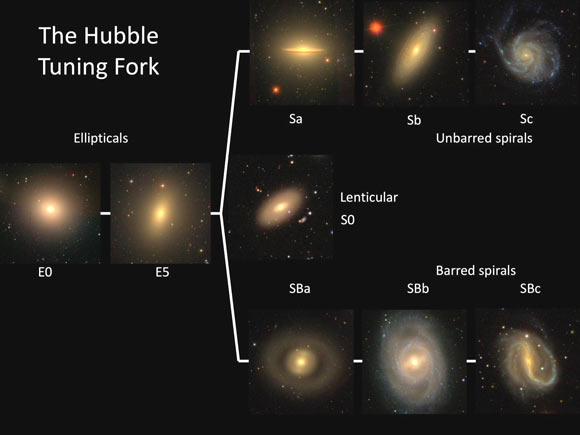Galaxies are important building blocks of the Universe. Some are simple, while others are very complex in structure. In 1927, as one of the first steps towards a coherent theory of galaxy evolution, the American astronomer Edwin Hubble developed a model to classify galaxies by type and shape. Known as the ‘Hubble tuning fork’ due to its shape, the model took account of two main features: the size of the galaxy’s bulge and how tightly wound any spiral arms are. Now, citizen scientists from the Galaxy Zoo project have helped to overturn this classification. The study has used classifications of over 6,000 galaxies to reveal that ‘well known’ correlations between these features are not found in this large sample.

The Hubble Tuning Fork illustrated with images of nearby galaxies from the Sloan Digital Sky Survey. Image credit: Karen Masters, Sloan Digital Sky Survey.
Hubble’s model is still used widely in astronomy textbooks. His key observation was that galaxies with larger bulges tended to have more tightly wound spiral arms, lending vital support to the density wave model of spiral arm formation.
Now though, in contradiction to Hubble’s model, the new work finds no significant correlation between the sizes of the galaxy bulges and how tightly wound the spirals are. This suggests that most spirals are not static density waves after all.
“This non-detection was a big surprise, because this correlation is discussed in basically all astronomy textbooks — it forms the basis of the spiral sequence described by Hubble,” said Haverford College’s Professor Karen Masters, Galaxy Zoo project scientist and lead author of the study.
Hubble was limited by the technology of the time, and could only observe the brightest nearby galaxies.
The new work is based on a sample 15 times larger from the Galaxy Zoo project, where members of the public assess images of galaxies taken by telescopes around the world, identifying key features to help scientists to follow up and analyze in more detail.
“We always thought that the bulge size and winding of the spiral arms were connected,” Professor Masters said.
“The new results suggest otherwise, and that has a big impact on our understanding of how galaxies develop their structure.”
There are several proposed mechanisms for how spiral arms form in galaxies.
One of the most popular is the density wave model — the idea that the arms are not fixed structures, but caused by ripples in the density of material in the disk of the galaxy. Stars move in and out of these ripples as they pass around the galaxy.
New models however suggest that some arms at least could be real structures, not just ripples. These may consist of collections of stars that are bound by each other’s gravity, and physically rotate together.
This dynamic explanation for spiral arm formation is supported by state-of-the art computer models of spiral galaxies.
“It’s clear that there is still lots of work to do to understand these objects, and it’s great to have new eyes involved in the process,” said Galaxy Zoo deputy project scientist Dr. Brooke Simmons, an astronomer with Lancaster University and the University of California, San Diego.
“It is remarkable that after over 170 years of observations of spiral arms in galaxies our understanding of them remains incomplete,” the astronomers concluded.
Their work was published in the journal Monthly Notices of the Royal Astronomical Society.
_____
Karen L. Masters et al. 2019. Galaxy Zoo: unwinding the winding problem – observations of spiral bulge prominence and arm pitch angles suggest local spiral galaxies are winding. MNRAS 487 (2): 1808-1820; doi: 10.1093/mnras/stz1153







